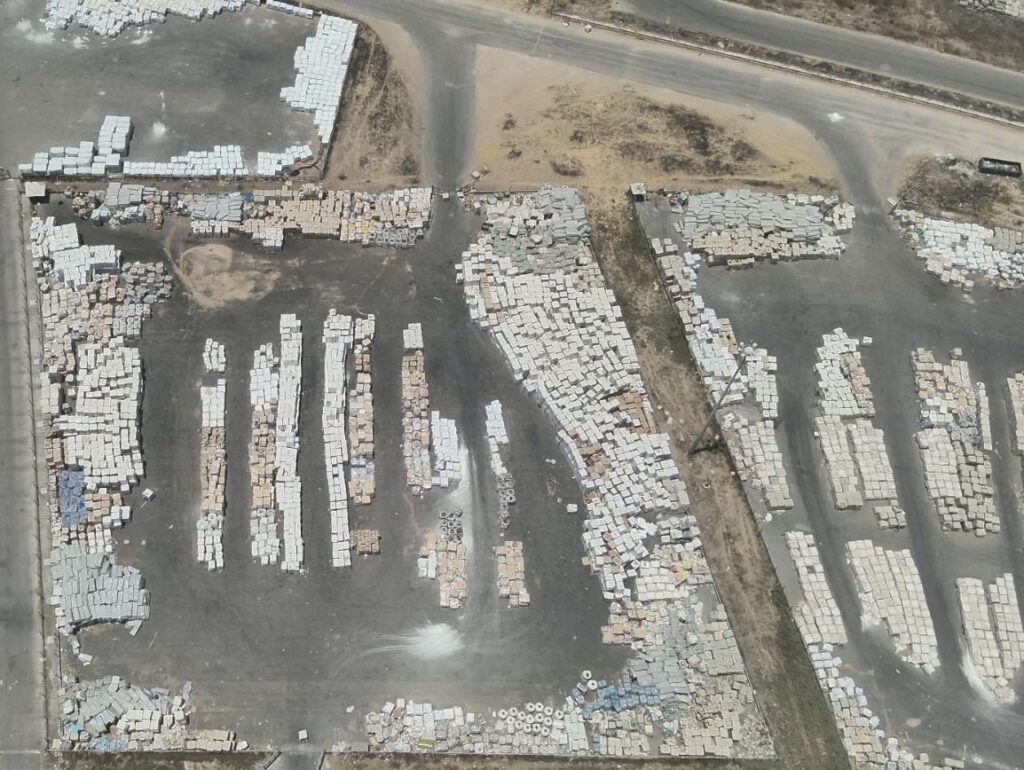FRESH AIR
Counting – and miscounting – Gaza aid trucks
June 20, 2024 | Alana Schetzer

UN admits it fails to track all aid trucks entering Gaza
The United Nations’ official data on the amount of aid being delivered to Gaza is not only unreliable but consistently undercounts the actual number of trucks going into the Strip.
The United Nations – through its Office for the Coordination of Humanitarian Affairs (OCHA) – recently admitted that it does not count all of the trucks entering Gaza. And yet it continues to push the narrative that insufficient quantities of food, medicines and other supplies are being delivered because of Israeli restrictions while citing these incomplete figures. Not only that, it is employees and agencies of the UN that have been the main driver of claims that the world’s only Jewish state engages in the war crime of deliberate starvation of civilians.
The fact that the UN is failing to count all of the aid trucks entering Gaza comes directly from OCHA’s own May 24 bulletin:
“Entry of aid supplies into Gaza continues to be limited. Between the start of the military operation in Rafah on 7 May and 23 May, only 906 truckloads carrying humanitarian assistance entered Gaza through all operating entry points, including 143 through Kerem Shalom Crossing, 62 through Erez, 604 through Erez West, and 97 through the floating dock. These figures do not include commercial trucks, as the UN has been unable to observe the arrival of private sector cargo through Kerem Shalom crossing due to insecurity. Supplies that are dropped off at the crossing without safety or logistical viability for humanitarian organisations to pick them up are also not included in these statistics [emphasis added].”
The numbers it has failed to add to the data set are not insignificant – a whopping 22 per cent of the total aid entering Gaza appears to be missing from the UN numbers. OCHA reports that 26,684 aid trucks entered Gaza between the start of the war on October 7 and June 5.
In comparison, Israel’s Coordination of Government Activities in the Territories (COGAT) agency reported a total of 34,199 trucks during the same period.
This discrepancy has become much worse in recent weeks.
COGAT says in May, 6,359 trucks entered Gaza, but the UN says it only collected and distributed aid from 1,479 trucks.
COGAT – a unit in the Israeli Ministry of Defence – recently conducted an in-depth investigation into the reasons for the discrepancy in data.
The COGAT study concluded that UNRWA, the highly controversial UN agency for Palestinian refugees which the UN has placed in charge of counting aid trucks, has struggled with the task. It has only been recording trucks that enter from the Kerem Shalom and Rafah crossings, excluding all other crossing points.
This means that the vast amounts of aid coming into Gaza via two northern crossings, Erez West and Erez East, as well as from airdrops, and the United States’ purpose-built aid pier are not included in the UN statistics.
But even at Kerem Shalom, most of the trucks that recently entered went unrecorded. COGAT counted 4,800 trucks entering Gaza from that crossing in May. The UN, via UNRWA, counted 1,416.
The discrepancy is likely partly explained by the fact that the UN is apparently only recording aid UN agencies distribute, even though multiple other agencies and countries are also distributing significant amounts of aid.
UNRWA also only records the aid after it has been picked up by UN agency trucks from the border.
And that process has been very slow. As of June 16, COGAT said there were 1,000 truckloads of aid, including perishable fruits and vegetables, piling up inside Gaza at Kerem Shalom, waiting to be picked up. COGAT confirmed this was still the case as of June 19.
Who’s counting at the UN?
It is also notable that before October 7, it was not UNRWA, but the UN’s Office for the Coordination of Humanitarian Affairs (OCHA) that collected and published data on aid entering Gaza.
UNRWA is a more controversial and political choice.
In late December 2023, UNRWA and the UN were rocked by “credible” evidence showing that multiple employees actively participated in the October 7 terror attacks against Israelis, and thousands more are members of Hamas and Islamic Jihad.
Questions are inevitably asked inside Israel whether there are individuals working for UNRWA, perhaps members of one of these terror groups – although UNRWA does not recognise Hamas as a terror group – who might have an interest in minimising aid delivery figures.
The underutilised humanitarian aid corridor
The UN claims it cannot distribute the aid in Gaza, even as more than a thousand truckloads await pick-up inside Gaza at Kerem Shalom, due to the breakdown in law and order within the territory, ongoing fighting, and looting of trucks, while also blaming Israel for creating barriers to effective distribution.
Such UN complaints were doubtless one of the factors that led Israel’s military to announce on June 16 that it was establishing a humanitarian aid corridor from Kerem Shalom into Rafah in which Israel will implement “a local, tactical pause of military activity for humanitarian purposes… from 08:00 until 19:00 every day until further notice.”

The route of the daily humanitarian aid corridor Israel recently announced
However, Israel has criticised the UN for failing to take full advantage of the newly established aid corridor. On June 16, UN aid agencies reportedly only picked up 92 truckloads of aid. The next day, COGAT said only “62 trucks… were collected from the Gazan side of Kerem Shalom, all by the private sector. Very few trucks were transferred by the UN aid agencies into Gaza.” On June 18, it said 100 were collected. On June 19, it was 88, and only 55 of these were collected from Kerem Shalom.
Meanwhile, more truckloads continue crossing into Gaza faster than agencies can collect them. According to COGAT, June 18 saw 305 truckloads enter – 289 via Kerem Shalom and 16 via the Erez crossing. June 19 saw 285 aid trucks enter Gaza. As noted above, the UN is clearly not collecting aid as fast as it is crossing the border, so the backlog inside Gaza at the crossing points is continuing to grow.
Although the UN continues to insist it cannot use the new corridor to its maximum potential because of a breakdown in law and order in the territory, Israel says the route has a military presence to ensure the safety of aid convoys.
False famine claims?
The UN’s misleading data regarding the quantity of aid reaching Gaza is having wider consequences. It is feeding into the global anti-Israel protest movement and fuelling antisemitic conspiracy theories. For example, it’s become commonplace to hear that Israel is ‘starving’ the Gazan population and deliberately obstructing access to Gaza.
Much of the media narrative faithfully reproduces the UN’s data, without questioning its validity. For instance, the New York Times published a story on May 27 with the headline “Access to Aid in Gaza Was Dire. Now, It’s Worse” even as COGAT data had showed a large surge of aid entering Gaza in the second half of May – something the article failed to mention.
However, a new report released on June 4 by a UN committee made up of five experts in food security and nutrition has cast doubt on claims that Gaza is experiencing a famine, as several UN agencies have previously claimed.
The Famine Review Committee (FRC) researched the situation in Northern Gaza and concluded that previous analyses that concluded Gaza was experiencing famine were not “plausible” given the “uncertainty and lack of convergence for the supporting evidence employed in the analysis.”
The FRC’s primary conclusions are summarised below:

This finding dovetails with several other studies.
A recently released Hebrew University study found the amount of food entering the enclave was adequate to feed all of Gaza’s residents. The Hebrew University’s conclusion was just confirmed by two Columbia University academics who did their own calculations to determine the amount of calories per person that has entered Gaza over recent months.
It is obviously welcome news that Gaza appears not to be experiencing famine as has been widely claimed. Nevertheless, all efforts must continue to ensure that that famine does not occur – but it seems clear the principal way to ensure it doesn’t happen is to improve the ability of agencies, especially UN agencies, to distribute food. The huge build-up of aid inside Gaza at Kerem Shalom demonstrates unequivocally that Israel is facilitating aid entry into Gaza quicker than the UN and other agencies are able to distribute it, and distribution clearly remains the key bottleneck in getting aid to Gazans who need it.
It is also important that accurate data is finally provided to the world, rather than the misleading information and, by the UN’s own admission, incomplete data that the UN continues to release to the media and public.
Tags: Gaza, Israel, UNRWA, United Nations
RELATED ARTICLES

The Government’s actions still fall short: Joel Burnie on FDD Morning Brief






















